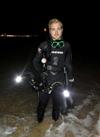
Eliot RUIZ le 17/04/19
Bonjour,
Savez-vous quel est cet organisme d'environ 1cm trouvé nageant dans les eaux côtières de l'Afrique du Sud ? Cette photo est une capture d'écran d'une vidéo (je ne sais pas mettre de vidéo sur DORIS) où l'on voit ce petit ver nageant à tout vitesse en direction de la surface. Il est même capable de s'arrêter de nager et de couler vers le fond lorsqu'il est dérangé ! Le panache filtreur et la forme générale fait vraiment penser à un polychète sédentaire tubicole... Mais comme il n'y a pas de segmentation apparente, peut être plutôt un phoronidé ? Ce pourrait-il que ce soit une larve aperçue dans son dernier stade avant de se sédentariser ?
Merci d'avance pour vos réponses !
Eliot RUIZ le 22/05/19
Okay, thank you very much Leslie! I imagine those other characters can only be seen under a binocular microscope...
Leslie Harris le 21/05/19
Yes, it certainly appears to be a spawning adult. Color patterns in polychaetes can be very useful if you know what patterns are unique to a single species and which can be shared with others. The pattern seen in your both animal and the South African worms is also found in species from other parts of the world so it is not diagnostic by itself. Other characters must be checked for identification of genus and species.
Eliot RUIZ le 21/05/19
Wow, well done! Must have been hard to find this post! I watched again the video and the worm is in fact very similar.
Therefore, this post reject the hypothesis of a larvae and confirm that it is a Polycirrinae isn'it?
It really look like the same species but it is? If yes, it must be widely distributed (South Africa//Solomon Islands) and resistant to temperature change because Sodwana Bay where it was spotted is less warm than Uebi (21-28°C//28-31°C). Any idea?
Leslie Harris le 21/05/19
Yes, it is surprising how well polycirrins can swim for spawning. An old post on facebook shows animals very similar to yours that were part of a mass spawning event. https://www.facebook.com/UepiIslandResort/photos/a.10150304490419321/10152681974759321/?type=3&theater
Eliot RUIZ le 21/05/19
Thank you very much Leslie! Does it means that the Polycirrinae terebellids are able to swim for an open-water spawning, a bit like an epitoky? Or is it just the common name of the family?
Alain-Pierre SITTLER le 21/05/19
Thank you very much for your opinion, Leslie.
(Pour ceux qui ne connaitraient pas Leslie Harris, qui est intervenue sur plusieurs post du forum récemment : elle est, entre autres choses concernant la faune et la flore des côtes californiennes, spécialiste des polychètes au Natural History Museum de Los Angeles).
Les textes et images sont sous licence et ne sont pas libres de droit.
Pour les ayants-droits, connectez-vous.
Pour toute demande d'utilisation (exemple d'un formateur Bio de la FFESSM...) contactez nous ici.